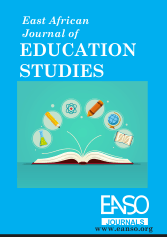Unmasking the Curse of out-of-School Primary-Age Children in Burkina Faso: an Empirical Investigation
Abstract
We empirically unmask a persistent challenge of out-of-school primary-age children in Burkina Faso. Utilising time-series data from the World Bank spanning 1971 to 2023, we apply the Autoregressive Integrated Moving Average (ARIMA) modelling technique to analyse trends in the percentage of primary-age children not enrolled in school. The Dependent Variable is Children out of school (% of primary school age), while moving average (MA) and autoregressive (AR) components function as independent variables. Parameter estimation using Conditional Least Squares reveals a statistically significant MA (6) coefficient of -0.817231, suggesting that approximately 82% of the shock in current out-of-school rates is explained by past errors. AR (1) coefficient of -0.565318 indicates that about 57% of the variation is influenced by its immediate past value. We find a strong trend of educational exclusion and thus recommend that policymakers design timely and data-driven interventions aimed at achieving universal primary education and meeting Sustainable Development Goal 4 (SDG 4) targets in Burkina Faso
Downloads
References
Asim, S., Chase, R., & Dar, A. (2017). Improving Education Outcomes in South Asia: Findings from a Decade of Impact Evaluations (Inglês). World Bank.
Avenstrup, R., Liang, X., & Nellemann, S. (2006). Kenya, Lesotho, Malawi and Uganda: Universal primary education and poverty reduction. World Bank.
Bashir, S., Lockheed, M., Ninan, E., & Tan, J. P. (2018). Facing Forward: Schooling for Learning in Africa. World Bank.
Becker, G. S. (1964). Human Capital: A Theoretical and Empirical Analysis, with Special Reference to Education. University of Chicago Press.
Box, G. E. P., Jenkins, G. M., & Reinsel, G. C. (2008). Time Series Analysis: Forecasting and Control (4th ed.). Wiley.
Creswell, J. W. (2014). Research Design: Qualitative, Quantitative, and Mixed Methods Approaches (4th ed.). SAGE Publications.
Enders, W. (2015). Applied Econometric Time Series (4th ed.). Wiley.
Filmer, D. (2005). Disability, poverty and schooling in developing countries: Results from 14 household surveys. World Bank Economic Review, 20(1), 141–163.
Gove, A., & Cvelich, P. (2011). Early Reading: Igniting Education for All. Research Triangle Institute.
Gujarati, D. N., & Porter, D. C. (2009). Basic Econometrics (5th ed.). McGraw-Hill Education.
Haavik, V., et al. (2022). The End of Stability – How Burkina Faso Fell Apart. African Security, Vol 15(4), 317-339.
Hamilton, J. D. (1994). Time Series Analysis. Princeton University Press.
Human Rights Watch. (2022). “Their War Against Education”: Armed Group Attacks on Teachers, Students, and Schools in Burkina Faso.
Hyndman, R. J., & Athanasopoulos, G. (2018). Forecasting: Principles and Practice (2nd ed.). OTexts.
Kattan, R. B., & Burnett, N. (2004). User fees in primary education. World Bank Policy Research Working Paper No. 30108.
Lewin, M. K. (2009). Access to Education in Sub-Saharan Africa: Patterns, Problems, and Possibilities. Comparative Review, 45, 151–174. http://dx.doi.org/10.1080/03050060902920518
Makridakis, S., Wheelwright, S. C., & Hyndman, R. J. (1998). Forecasting Methods and Applications (3rd ed.). Wiley.
Marquardt, D. W. (1963). An Algorithm for Least-Squares Estimation of Nonlinear Parameters. Journal of the Society for Industrial and Applied Mathematics, 11(2), 431–441.
Ministère de l’Éducation Nationale. (2019). Rapport d’évaluation du PDDEB. Ouagadougou.
NRC. (2021). Education Under Attack in West and Central Africa. Norwegian Refugee Council. https://www.nrc.no/
Sabates, R., Akyeampong, K., Westbrook, J., & Hunt, F. (2010). School dropout: Patterns, causes, changes and policies. UNESCO GMR Background Paper.
Stock, J. H., & Watson, M. W. (2015). Introduction to Econometrics (3rd ed.). Pearson.
Tomasevski, K. (2006). The State of the Right to Education Worldwide: Free or Fee. Global Report.
UNESCO. (2015). Education for All 2000–2015: Achievements and Challenges. Paris: UNESCO Publishing.
UNESCO. (2022). Global Education Monitoring Report 2022: Non-State Actors in Education – Who Chooses? Who Loses? Paris: UNESCO.
UNESCO UIS. (2022). Out-of-School Children Data. http://uis.unesco.org/
UNICEF. (2019). Education under threat in West and Central Africa. https://www.unicef.org/child-alert/education-threat-west-central-africa
UNICEF. (2021). Progress for Every Child: Enrolling Out-of-School Children in West and Central Africa. New York: UNICEF.
UNICEF. (2021). The State of the World’s Children 2021: On My Mind – Promoting, Protecting and Caring for Children’s Mental Health. UNICEF.
UNICEF. (2022). Education Statistics. https://data.unicef.org/
Winthrop, R., & Kharas, H. (2018). Education for Fragile States. Brookings Institution.
World Bank. (2018). World Development Report 2018: Learning to Realize Education’s Promise. Washington, D.C.: World Bank.
World Bank. (2023). World Development Indicators. https://data.worldbank.org/
Wooldridge, J. M. (2013). Introductory Econometrics: A Modern Approach (5th ed.). Cengage Learning.
Copyright (c) 2025 Kagarura Willy Rwamparagi, Nahabwe Patrick Kagambo John

This work is licensed under a Creative Commons Attribution 4.0 International License.




























